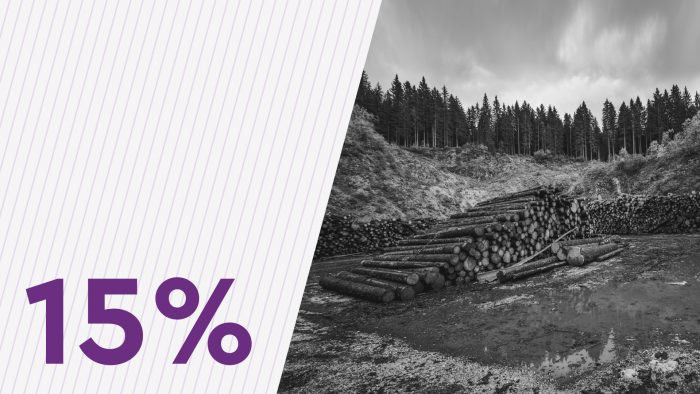

Timber construction has a lower
carbon footprint accross its whole life
The way the timber industry accounts for carbon is possibly misleading and does not necessarily deliver the most sustainable outcomes. A primary argument used to promote timber in construction is the claim that it has a lower carbon footprint. However, there are still too many uncertainties with respect to timber carbon accounting to draw any general conclusions.
There is concern that increased demand for timber will promote unsustainable forestry practices that will be damaging to the climate. A strong case can be made that concrete is often the lower carbon option in comparison with timber. Carbon losses from the soil arise from intensive forestry practices. Studies have also found that as little as 15% of the carbon stored in a standing tree is sequestered in the final wood product (International Institute for Sustainable Development 2019). It is a misconception to say that timber is more carbon efficient than concrete.

This view often arises because of the overlooked fact that the carbon dioxide that is sequestered at the start of its lifecycle is emitted at the end
Carbon emissions during stages of production are often not taken into account, such as transportation costs and chemical additives. The International Institute for Sustainable Development has challenged wood lifecycle carbon assessment (LCA) studies which assume that all harvested carbon is sustainably replaced by new forest growth in the future. The operational reality is that replacement rates do not achieve carbon neutrality.
To know if a material is really ecological, it is important to look at the whole life of the product from sourcing/extraction of raw materials, including the different processes, treatments and transportation in use maintenance and end of life.
Life cycle analysis is an uncertain science, and carbon emissions and sequestration related to the production and end-of-life stages of wood building products hold the most significant uncertainties in existing lifecycle carbon assessments (International Institute for Sustainable Development 2019).
The fight against climate change must be based on accurate facts about timber, not uncertainty. Timber production forests are being managed to produce a construction material and not as an essential CO2 storage asset. As a result, they are a less effective carbon store than a natural forest.
The producers of timber materials must be more transparent. The consequential damage from production on forest CO2 stocks, soil erosion and forest changes are often missing from timber product declarations.
The International Institute for Sustainable Development has challenged wood lifecycle carbon assessment (LCA) studies which assume that all harvested carbon is sustainably replaced by new forest growth in the future. The operational reality is that replacement rates do not achieve carbon neutrality.
The truth is that the carbon is emitted at end of life, and sometimes emitted as methane, a gas with higher Greenhouse Warming potential. Millions of tonnes of waste wood ends up in landfill emitting millions of tonnes of CO2. At end-of-life, treated wood cannot be recycled or valued in the same way as non-treated wood. By burning it, one cubic meter of wood release one tonne of CO2 (being the same quantity absorbed during its growth).

Concrete can be reused and is 100% recyclable

Concrete by contrast can be reused and at end of life is 100% recyclable. The long-term case for concrete is based on the cement industry reducing its carbon emissions by 19% since 1990 and accelerating its actions with an ambition of carbon neutral concrete by 2050 (GCCA in Numbers, 2020).
Today, concrete suppliers and designers, and in turn their clients and customers, can also minimise carbon footprint by: optimising mixes, the efficient use of materials, and recognising the carbon uptake potential of concrete to permanently sequester CO2 in buildings.